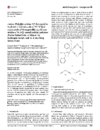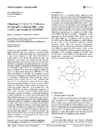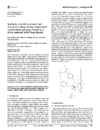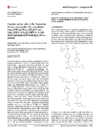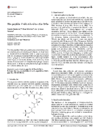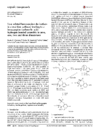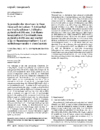issue contents
April 2014 issue

Cover illustration: The crystal structure of MgAu2Ga, showing views of the unit cell along two different directions. See Smetana, Corbett & Miller [Acta Cryst. (2014), C70, 355-358].
international union of crystallography
Free 

scientific comment
Download citation


Download citation


A new refinement of Ni5.20Sn8.7Zn4.16Cu1.04 based on the originally published structure factors was performed and indicates that the structure can be described in the centrosymmetric space group Pm m; no justification for the absence of the inversion centre could be found within the accuracy of the available data.
m; no justification for the absence of the inversion centre could be found within the accuracy of the available data.
CCDC reference: 987517
inorganic compounds
Download citation


Download citation


The crystal structure of a mixed-valence iron phosphite has been solved from single-crystal X-ray diffraction data in the trigonal space group R m. The compound shows anionic [Fe3(HPO3)4]2− and [Fe(HPO3)2]− sheets stacked in a disordered manner along the c axis, with the K+ cations located in the interlayer spaces.
m. The compound shows anionic [Fe3(HPO3)4]2− and [Fe(HPO3)2]− sheets stacked in a disordered manner along the c axis, with the K+ cations located in the interlayer spaces.
CCDC reference: 988088
Download citation


Download citation


MgAuGa is the first ternary representative of the Mg–Au–Ga system. It adopts the Fe2P structure type (Pearson symbol hP9) and closely resembles hexagonal Mg2Ga through a direct group–subgroup relationship. MgAu2Ga also crystallizes hexagonally and is isotypic with Na3As. It adopts the structure of another binary compound, viz. Mg3Au (hP8), but shows an unexpected distribution of Mg, Au, and Ga among the atomic positions of the asymmetric unit compared to Mg3Au.
metal-organic compounds
Download citation


Download citation


In a one-dimensional coordination polymer containing approximately square-pyramidal CuII, with one bridging and one terminal dicyanamide ligand, the polymer chains are linked by hydrogen bonds and π–π stacking interactions.
CCDC reference: 990184
Download citation


Download citation


The four Co atoms of a novel tetranuclear mixed-valence cobalt complex display distorted octahedral coordination environments and are bridged by two 2-[(oxidoimino)methyl]-6-methoxyphenolate ligands, two 2-[(hydroxyimino)methyl]-6-methoxyphenolate ligands and two azide anions to form a tetranuclear [Co4N4O4] cluster. Adjacent clusters are connected through weak C—H⋯N and C—H⋯O interactions.
CCDC reference: 990518
Download citation


Download citation


The structure of a new triclinic polymorph of Fe(OEP)Cl has been determined. The high-spin five-coordinate heme unit and axial ligation are essentially the same as previously determined, with an average Fe—N bond length of 2.075 (2) Å, an axial Fe—Cl bond length of 2.225 (4) Å, and the iron cation displaced by 0.494 (4) Å. Common features of the porphyrin plane–plane and supramolecular stacking are identified. The main molecular differences between the two polymorphs are in the orientations of the ethyl side chains on the periphery of the porphyrin core.
CCDC reference: 990083
Download citation


Download citation


Two homochiral coordination polymers both have a three-dimensional network structure with a one-dimensional channel. An investigation of the photoluminescence properties shows that one of the compounds displays a strong emission in the purple region.
Download citation


Download citation


In the Ag complex of N-[(diphenylphosphanyl)methyl]pyridin-4-amine (DPP) with perchlorate, the unique Ag+ cation has a near-linear coordination geometry consisting of one pyridine N atom and one P atom from two different DPP ligands. In the analogous complex with nitrate, the nitrate anions weakly chelate to each Ag+ cation, leading to each Ag+ cation having a distorted tetrahedral coordination geometry consisting of one pyridine N atom and one P atom from two different DPP ligands, and two chelating nitrate O atoms.
Download citation


Download citation


A sawhorse-type dinuclear ruthenium complex with two bridging perfluoroheptanoate ligands and two dimethyl sulfoxide ligands in the axial positions is a new example of a compound with an aliphatic fluorinated carboxylate ligand and a direct Ru—Ru interaction. The compound is an active catalyst in transvinylation of propionic acid with vinyl acetate.
CCDC reference: 993034
organic compounds
Download citation


Download citation


Dihydroberberine, a reduced form of pharmacologically important berberine, crystallizes from ethanol without interstitial solvent. Although lacking classical O—H or N—H donors, the packing in the crystalline state is clearly governed by C—H⋯N and C—H⋯O hydrogen bonds involving the two acetal-type C—H bonds of the 1,3-dioxole ring.
CCDC reference: 987722
Download citation


Download citation


A new polymorph of the cinnamic acid–isoniazid cocrystal is characterized by hydrogen-bonded tetrameric arrangements of two molecules of isoniazid and two of cinnamic acid. Possible modification of the hydrogen bonding was investigated by changing the hydrazide group of isoniazid by an in situ reaction with acetone and cocrystallization with cinnamic acid.
Download citation


Download citation


In a monohydrated cocrystal of 1,3,5-triamino-1,3,5-trideoxy-cis-inositol and its hydroiodide salt, the cation, but not the neutral inositol unit, exhibits intramolecular O—H⋯O hydrogen bonding. The neutral and cationic inositol entities are each aligned into chains along [001]. In these chains, two O—H⋯N interactions generate a ten-membered ring as the predominant structural motif.
CCDC reference: 990156
Download citation


Download citation


The five-membered furanose ring of three fluoro- or chloro-substituted 1′-deoxy-1′-phenyl-β-D-ribofuranoses has a conformation between a C2′-endo,C3′-exo twist and a C2′-endo envelope. The ribofuranose groups are connected by O—H⋯O hydrogen bonds to symmetry-related molecules to form layers. The orientation of the benzene ring is independent of the substitution pattern of the ring and depends mainly on crystal-packing effects.
Download citation


Download citation


A peptide is reported which is a left-handed helix with a right-handed conformation in the fourth residue, which is the only chiral residue. There are two 4→1 intramolecular hydrogen bonds. In the crystal structure, molecules are linked by hydrogen bonds along the c axis.
CCDC reference: 991221
Download citation


Download citation


Four related compounds exemplify the reaction sequence from a 1,4-epoxybenzazepine ester via its reduction product, a benzazepin-4-ol ester, and the corresponding hydroxy carboxylic acid, to a lactone as formed by intramolecular condensation.
Download citation


Download citation


Three 5,6-trimethylenepyrimidin-4-one derivatives display a combination of N—H⋯O, N—H⋯S, C—H⋯O and C—H⋯N hydrogen bonds. The study of the molecular and supramolecular structures of thiouracil derivatives is significant in the development of lipoprotein-associated phospholipase A2 inhibitors.


 journal menu
journal menu















